Rome in the Early Republic (509 - 241 BC)
C. Servilius M. f., Praetor of CIL VI 40896a


Rome in the Early Republic (509 - 241 BC)
C. Servilius M. f., Praetor of CIL VI 40896a
This page is devoted to the identification of two members of the gens Servilia who can be associated with buildings on the Tiber Island:
✴Caius Servilius, who dedicated a temple of Vediovis on the Tiber Island as duovir aedis dedicandae in 194 BC (Livy, ‘History of Rome’, 34: 53: 7); and
✴Caius Servilius, son of Marcus, who was recorded in an inscription (CIL VI 40896a - discussed below) as the praetor responsible for the construction of a mosaic pavement on the present site of the Ospedale Fatebenefratelli on the island: according to Manfredi Zanin (referenced below, at p. 225), this pavement dated to the 2nd or 1st century BC.
The exact location of the temple of 194 BC can no longer established with any certainty. If these two Servilii Geminii could be securely identified, then the nature of the association between the temple and the structure containing the mosaic pavement might become clearer.
Family Tree of the Servilii Gemini
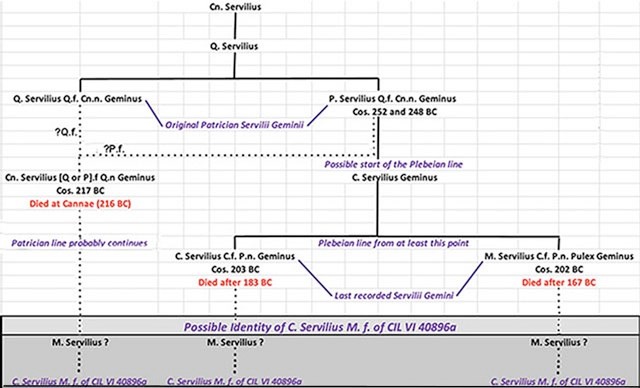
Possible identity of C Servilius M. f. Servilius, praetor of CIL VI 40896a
From the information we have so far, we might also reasonably assume that:
✴both C. Servilius, the duovir of 194 BC, and C. Servilius M.f., the praetor of the 2nd or 1st century BC, belonged to the Servilii Gemini, since this branch of the family employed the cognomina Caius and Marcus (along with Cnaeus, Quintus and Publius); and
✴the duovir of 194 BC belonged to the same generation as the grandfather of the praetor of the 2nd or 1st century BC (and might have been his grandfather).
This family tree is based on the following considerations. We know:
✴from Cicero (‘Academica’, 2: 84, translated by Harris Rackham, referenced below, at p. 573), that Publius Servilius Geminus, the consul of 252 and 248 BC, had a twin brother, Quintus, which would account for the cognomen Geminus; and
✴from the fasti Capitolini, that their father was called Quintus and their grandfather was called Cnaeus.
The fasti Capitolini also allow us to place three other consuls on this diagram:
✴[Cn. Servilius P or Q.f.] Q.n. Geminus, cos. 217 BC;
✴C. Servilius C.f. P.n. Geminus, cos. 203 BC; and
✴M. Servilius C.f. P.n. Pulex Geminus, cos. 202 BC.
The cognomen Geminus seems to have fallen out of use by the Servilii at this point.
Unfortunately, since Livy omitted the filiation of the duovir of 194 BC, we do not know his precise identity. Eric Orlin (referenced below, at p.174 and note 39) pointed out that he is usually assumed to be C. Servilius Geminus, cos. 203 BC. However, Orlin observed that:
“The majority [of those who served as duoviri aedi dedicandae at this time] were men at the start of their careers, who had held no office before dedicating the temple.”
He acknowledged that Geminus could have been exceptional in this respect, but observed that:
“It is [also] possible that [the duovir of 194 BC] was an undistinguished [and now unknown] member of the family, whose career never got off the ground, despite his dedication of [this temple].”
I return to this debate below, after an analysis of the likely identity of the praetor of CIL VI 40896a.
Candidates for the Praetor of CIL VI 40896a

Right and left parts of CIL VI 40896a, adapted from Manfredi Zanin (referenced below, Figures 5 and 6)
Originals: © Berlin-Brandenburgische Akademie der Wissenschaften
Corpus Inscriptionum Latinarum. Foto-Archiv CIL, Inv.-Nr. PH0007666 (bzw. 7667)
The inscription (CIL VI 40896a), which (as noted above) was embedded in a mosaic pavement, was unearthed during (essentially unpublished) excavations in 1989-94 under the Cortile dei Pesci of the Ospedale San Giovanni Calibita Fatebenefratelli. It was originally in a single line and now survives in two fragments, which have been published as:
C(aius) Serveili(us) M(arci) f(ilius) pr(aetor)
[---?] Serveilieis C f faciendum coeraverunt eidemque probavẹ[runt]
The phrase ‘Serveilieis’ C f’’ in the right part of the inscription implies the intervention of at least two of the praetor’s sons, and there is room for the praenomina of three. On this basis, the inscription is usually translated and completed as:
“Caius Servilius, son of Marcus, praetor [---?, C(aius), M(arcus), P(ublius)?], sons of [presumably C.] Servilius have undertaken, taken charge of and approved (this work)”.
In principal, as illustrated in the family tree above, any of the consuls of 217, 203 0r 202 BC (along with other, now unknown, Servilii Gemimini) could have had a son called Marcus who was the father of the praetor of CIL VI 40896a. However, we can potentially narrow down the options by considering two other records of a man called C. Servilius M.f. that can be found in our surviving sources for this period:
✴a tresviri monetalis of 136 BC; and
✴the father of P. Servilius Vatia Isauricus, who is recorded in the fasti Capitolini as P. Servilius C.f. M.n. Vatia, cos. 79 BC.
I discuss each of these candidates below, since it is possible that one or both of them could actually be the praetor who is commemorated in this inscription.
C. Servilius M.f., Tresvir Monetalis of 136 BC
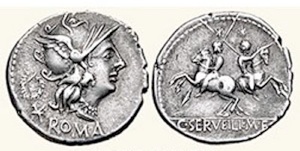
Denarius (RRC 239 1 , 136 BC) issued by C. Servilius M.F
Obverse: helmeted head of Roma
Reverse: Dioscuri (the twins Castor and Pollux) riding apart, with spears reversed
This coin, which depicts Roma on the obverse and the Dioscuri on the reverse, is one of a number with this iconography that were issued in Rome from 211 BC (see, for example, RRC 44/5) and remained essentially unchanged until 121 BC (see, for example, RRC 278/1). However, as Amber Gartrell (referenced below, at pp. 122) observed, although the reverse of Servilius’ denarius conforms to this tradition in some respects, it is unique in its representation of the Dioscuri galloping away from each other rather than (as in the other coins of this type) galloping right. This ‘personalised’ reverse was an early example of a break with traditional coin types that Michael Crawford (referenced below, at p. 728), associated with the lex Gabinia tabellaria of 139 BC, which mandated the secret ballot for the election of magistrates in all assemblies: as he pointed out:
“... the end of voting by show of hands meant the end of easy control by noble candidates of [their] supporters; use of the coinage was an obvious way in which men could attempt to bring their claims to [wider] public notice.”
Crawford also commented (at p. 729) on:
“... the remarkable fact [that] ... some moneyers in the period held office within 10 years of their consulates. It is hard to avoid the conclusion that the moneyership ... [had been, in these cases] a substitute for the aedileship: self-advertisement was a feature of both offices.”
In his description of this coin (at p. 271). Crawford observed that the reverse type:
“... presumably alludes to [the issuer’s] descent from P. Servilius Geminus (coss. 252 and 248 BC) ...”
However, that does not explain why Servilius eschewed the traditional representation of the Dioscuri galloping right. Furthermore, at least as far as we can tell from the surviving sources, there was nothing particularly memorable about this particular ancestor (apart from the fact that he had an identical but apparently otherwise undistinguished twin). It seems to me that a subsequent event in the affairs of this branch the family would have been more relevant to the putative aspirations of this particular moneyer: as Rachel Feig Vishnia (referenced below, at p. 289) explained, while:
✴P. Servilius Geminus (coss. 252 and 248 BC) and Cn. Servilius Geminus (cos. 217 BC) were patrician;
✴C. and M. Servilius Geminus (respectively cos. 203 and cos. 202 BC) were plebeian.
Unfortunately, it is not possible to determine whether this transition was made by the respective consuls themselves or their father, C. Servilius P. f. Geminus: all we know (from Livy) is that, in 209 BC, when Caius junior was elected as plebeian aedile:
“It was asserted that [he] had no legal right to be either tribune of the plebs or aedile, because there was sufficient evidence that his father, who was supposed to have been killed by the Boii near Mutina 10 years previously when acting as a land commissioner, was really alive and a prisoner in the hands of the enemy”, (‘History of Rome’, 27: 21: 9-10).
The political opposition to the younger Caius did not apparently impede his career: as we have seen, he went on to become the first plebeian consul from the gens Servilia in 203 BC (when he served as the plebeian colleague of the patrician Cn. Servilius Cn.f. Cn.n. Caepio). It is thus entirely possible that the unique reverse of RRC 239/1 would have been taken as a reference to this change in the status of the moneyer’s branch of the Servilii Gemini, when C. Servilius Geminus (cos. 203 BC) and M. Servilius Geminus (cos. 202 BC) metaphorically galloped off in the direction of the plebeians while other Servilii Gemini (including Cn. Servilius Geminus, the future consul of 217 BC) retained their patrician status. On this basis, C. Servilius M. f., the moneyer of 136 BC, could have been the grandson of either C. Servilius Geminus (cos. 203 BC) or M. Servilius Geminus Pulex (cos. 202 BC).
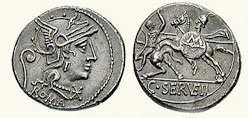
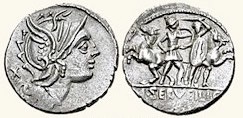
Denarius (RRC 264/1 , 127 BC) issued by C. Servilius Denarius (RRC 327/1 , 100 BC) issued by M. Servilius C.f.
Obverse: helmeted head of Roma Obverse: helmeted head of Roma
Reverse: two men in single combat, one shield marked ‘M‘ Reverse: two men in single combat
We can take the analysis further by considering two slightly later denarii that were issued by relatives of the moneyer of 136 BC:
✴one issued in 127 BC by C. Servilius (no filiation); and
✴one issued in 100 BC by M. Servilius C.f., who was presumably his son.
Both of these denarii have reverses that depicted M. Servilius Pulex Geminus, cos. 202 BC, who was renowned for his success in single combat against enemies of Rome. Like his brother (discussed above), he was long-remembered in Rome. For example, Livy recorded that, in 167 BC, the aged Pulex began a speech in the Senate by insisting that he should be heard because (inter alia):
“... I have fought in single combat on 23 occasions and I carried off the spoils from all of these opponents. My body is covered with honourable scars, every one received in front”, (‘History of Rome’, 45: 39: 16).
Two other elements of the designs on the earlier coin confirm the reference to Pulex:
✴the lituus on the obverse alludes to the fact that he had joined the augural college in 211 BC; and
✴the ‘M’ on the shield on the reverse confirms his identification.
It is thus almost certain that M. Servilius Geminus Pulex (cos. 202. BC) was the grandfather of the moneyer of 127 BC and the great grandfather of the moneyer of 100 BC.
C. Servilius M.f., Tresvir Monetalis of 136 BC: Conclusions

Probable identities of the Servilii moneyers of 136, 127 and 100 BC and the praetor of CIL 40896a
The likelihood is that C. Servilius M. f., the moneyer of 136 BC, used his filiation on his coins in order to differentiate himself from the moneyer of 127 BC. It follows from this that, although we do not know the name of the father of the latter moneyer, we do know that it was not Marcus (pace Michael Crawford, referenced below, at p. 270). Thus, we might reasonably assume that the moneyer of 136 BC was the grandson of of the consul of 203 BC.
This conclusion has not been universally accepted, For example, Ernst Badian (referenced below, at p. 52) rejected this possibility. arguing that:
✴the full name of the grandson of the consul of 203 BC was C. Servilius M. f. Vatia; and
✴had he been a moneyer, he would have identified himself by means of his cognomen rather than by his filiation.
Thus, in Badian’s view, the moneyer of 136 BC must have been the son of another M. Servilius. Badian’s first argument (discussed further below) is almost certainly correct. However, Manfredi Zanin (referenced below, at pp. 228-9) has convincingly established that the his second argument is flawed, and his line of reasoning led him to the conclusion (illustrated in his Table 16) that C. Servilius M.f, the moneyer of 136 BC, was the grandson of the plebeian consul of 203 BC.
It follows that the reverse of the denarius of 136 BC would have been understood as a reference to the moneyer’s grandfather, C. Servilius Geminus (cos. 203 BC). Although he seems to have been less colourful than his brother (the fearless Pulex), Livy noted that he achieved one notable thing during his otherwise uneventful consulship:
“... he rescued his father, C. Servilius, and also C. Lutatius after 16 years of servitude, the result of their capture by the Boii at Tannetum. When the consul returned to Rome with his father on one side of him and Lutatius on the other, he was honoured more on personal than on public grounds”, (‘History of Rome’, 30: 19: 7-8).
This outstanding example of filial pietas, a virtue that was highly valued in Roman culture, would certainly have been worthy of commemoration on a coin issued by an ambitious descendant at the start of his career.
C. Servilius M.f., Father of P. Servilius Vatia (Cos. 79 BC)
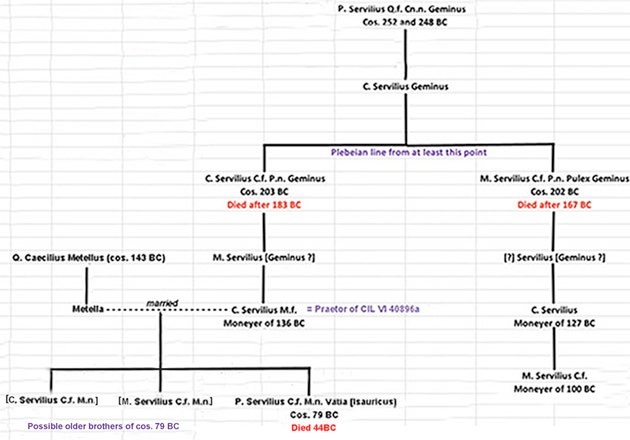
Probable family tree of P. Servilius Vatia (cos. 79 BC)
As noted above, the fasti Capitolini name the plebeian consul of 79 BC as P. Servilius C.f. M.n. Vatia and note that he was later called Isauricus. (He was awarded this agnomen after his triumph over the Isauri in Cilicia in 74 BC). Thus, if we accept that the father of the moneyer of 127 BC, then this consul fits neatly into the family tree as the son of C. Servilius M.f., the moneyer of 136 BC.
We happen to know the approximate date of Publius’ birth: a surviving fragment of a now-lost passage by Aelian (Fr. 113, preserved at Suda: α 3213) indicates that he lived to be 90 years old, and Cassius Dio (‘Roman History’, 45: 16: 1) recorded his death at an advanced age in 44 BC. Thus, he would have been born in ca. 134 BC. It is usually assumed that he had two older brothers, one called Caius (after his father) and the other Marcus (after his grandfather). They are sometimes identified with two Servilii who were recorded in the context of the Second Sicilian Slave War (104-100 BC):
✴‘Servilius the augur’, who successfully prosecuted L. Licinius Lucullus, the praetor in Sicily in 103 BC, on his return to Rome (Plutarch, “Life of [the Younger] Lucillus’); and
✴‘C. Servilius’, Lucullus’ successor as praetor in Sicily in 102 BC (Diodorus Siculus, ‘Library of History’, 36: 9: 1).
However, there is no hard evidence for this (and it seems to me that a consideration of the family tree of Publius’ maternal grandfather, discussed below, makes this highly unlikely).
Q. Caecilius Metellus (cos. 143 BC), Maternal Grandfather of P. Servilius Vatia
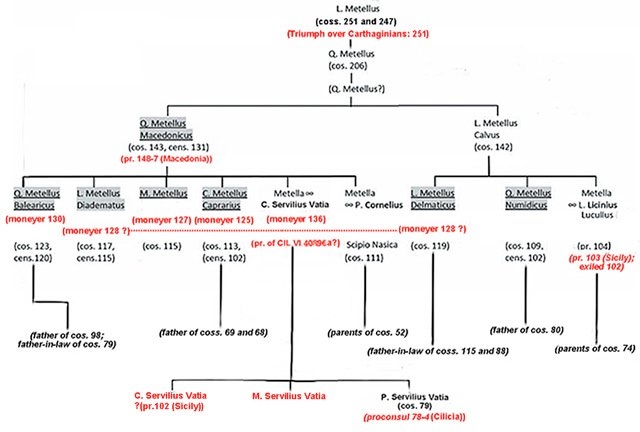
Family tree of the Caecilii Metelli
Adapted from Karl-Joachim Hölkeskamp (referenced below, at p.51: my additions in red
Cicero is our source for the identity of Publius’ maternal grandfather: in his speech for the prosecution in the corruption trial of C. Verres, the former governor of Sicily, in 70 BC, Cicero observed that Publius (who was one of the judges in the case):
“... held his command in [Cilicia] for five years [78-4 BC]: if he had been [like] Verres, he could have amassed a vast sum of money. [However, he] felt himself debarred from doing anything that he had not seen done by his father or his illustrious [grandfather], Q. Metellus)”, (‘In Verrem’, 2: 3: 211, translated by Leonard Greenwood, referenced below, at p. 259).
This indicates that Publius’ father had married a daughter of Q. Caecilius Metellus Macedonicus (cos. 143 BC).
Cognomen of C. Servilius M. f., Moneyer of 136 BC
In the family tree of the Caecilii Metelli reproduced above, Publius’ father is given the cognomen Vatia. Although there is no hard evidence for this, it is suggested in a now-lost satirical passage by Lucilius, cited by Nonius:
“Nonius: ‘vatax’ and ‘varicosus,’ having deformed feet ... as if ... an ancient lineage, from which have sprung Quintus Maximus and the swell-veined, splay-footed ...”, (‘Satires’, 29: 850, translated by Eric Warmington, referenced below, at p. 275)
Eric Warmington, the translator of the passage above, observed (at note b) that ‘vatax’ (which might mean bandy-legged):
“... possibly puns on a man named Vatia, ... [perhaps] C. Servilius, the father of P. Servilius Vatia (later Isauricus) ...”
He pointed out (at p. xii) that Book 29 of the ‘Satires’ was probably finished before the death of Scipio Aemilianus (Lucilius’ patron) in 129 BC (when Publius would have been about five years old and his oldest brother is unlikely to have been older than 15). Ernst Badian (referenced below, at p. 52) was therefore unequivocal:
“It clear that the ... father [of the consul of 79 BC also] bore the name of Vatia: ... it happens to be attested a ... in the earliest part of [the ‘Satires’ of Lucilius], where it really cannot apply to anyone else.”
Manfredi Zanin (referenced below, at p. 228), who assumed (with Warmington - see his note b) that Lucilius’ ‘Q. Maximus’ was either Q. Fabius Maximus Aemilianus (cos. 145 BC) or his son, Allobrogicus (cos. 121 BC), argued that, before jumping to any conclusion on the identity of Vatax :
“... it is essential to understand whether Luculius’ reference to an ‘ancient lineage’ alluded to:
✴a single family (evidently the Fabii); or
✴more generally, to the Roman people as a whole.
Only if [the second of these is the correct interpretation could] ‘Vatax’ belong to a family other than the Fabii and thus be identified without difficulty as C. Servilius Vatia. However, [nothing allows us to make] a decisive choice”, (my translation).
However, it seems to me that ‘Q. Maximus’ could alternatively have meant:
✴Q. Fabius Maximus Servilianus (cos. 142 BC); or
✴Q. Fabius Maximus Eburnus (cos 116 BC, censor of 108 BC) whom Robert Cram (referenced below, p. 98 and note 1) identified as Servilianus’ son, and who is probably the ‘Q. Max’ who issued the coins catalogued as RRC 265 (127 BC).
Simon Northwood (in the work edited by T. C. Cornell, referenced below, at I: pp. 227-9, II: pp. 282-7 and III: pp. 192-4) gave a comprehensive account of Servilianus’ career (in the context of his writings on Roman history). The relevant information for our purposes is that:
✴he was the adopted son of Q. Fabius Maximus Aemilianus and the natural son of a Servilius, probably Cn. Servilius Caepio; and
✴he was cited by other authors as ‘Fabius Maximus’ (by both Dionysius of Halicarnassus and ‘Servius Danielis’) and as ‘Fabius Servilianus’ (in the Scholia Veronensia).
Thus, ‘Q. Maxiumus’ and the unidentified vatax could both have sprung from the ancient lineage of the gens Servilia, in which case, Zanin’s objection would fall. It seems to me that badian was righ in asserting that Lucilius was indeed probably punning on the name of C. Servilius M. f. Vatia, the father of the consul of 79 BC.
C. Servilius M.f., Praetor of CIL VI 40896a: Conclusions
I established above that C. Servilius M.f, the moneyer of 136 BC, was also:
✴the father of P. Servilius C.f. M.n. Vatia, and probably also the father of two older boys named Caius (for their farther) and Marcus (for their grandfather); and
✴the son-in-law of Q. Caecilius Metellus Macedonicus (cos. 143 BC);
and that his full name was almost certainly C. Servilius M. f. Vatia. I suggested that both his marriage into the gens Caecilii Metellii and his precocious use of a ‘personalised’ reverse design on his coins in 136 BC mark him out as a man of marked ability and ambition.
We can deduce that Vatia held the praetorship from the passage by Cicero discussed above, in which he observed that, when his sone, Publius (one of the judges in the trial of C. Verres) governed Cilicia as pro-consul in 78-4 BC, he:
“... felt himself debarred from doing anything that he had not seen done by his father or his illustrious [grandfather], Q. Metellus)”, (‘In Verrem’, 2: 3: 211, translated by Leonard Greenwood, referenced below, at p. 259).
Cicero asserted here that Publius’ grandfather had governed Macedonia in 148-7 BC with exemplary probity, in a manner that contrasted sharply with Verres alleged abuse of his position as governor of Sicily in 73-70 BC. To make his point even more emphatically, Cicero asserted that Publius had looked to his father for another example probity in high office. Corey Brennan (referenced below, at p. 903, note 161) reasonably argued that this:
“... clearly implies that [Publius’] father had also held a command in an armed provincia (and so as praetor ?) ... .”
In short, nothing in the analysis so far precludes the equation of C. Servilius M. f. Vatia, the moneyer of 136 BC with the praetor commemorated in the inscription CIL VI 40896a. Furthermore, he is the only known member of the gens Servilia who can be equated with this praetor. It is therefore reasonable to assume that they were one and the same man.
Date of the Praetorship of C. Servilius M.f. Vatia
We have now established with a reasonable level of certainty that Vatia served as tresvir monetalis in 136 BC and that his third son was born two years later (as indicated in blue in the table above).
The next step is to establish how long it normally took for a moneyer to reach the praetorship. Unfortunately, only scant evidence for this is available in our surviving sources: Michael Crawford (referenced below, at p. 708) found only four moneyers in the period 137-29 BC who were subsequently documented as praetor, and we should probably remove Q. Fabius Maximus Eburnus, the moneyer of 127 BC, from his list since, as Corey Brennan (referenced below, at p. 226) explained, the Macedonian praetorship that Crawford assigned to him in 119 BC had more probably been held by his father in 145/4 BC. The other three possible precedents for the likely career path of Vatia are:
✴Sex. Pompeius: tresvir monetalis in 137 BC; praetor (Macedonia) in 121-119 BC (gap 16 years);
✴L. Opeimus (cos. 121 BC): tresvir monetalis in 131 BC; praetor (special provincia at Fregellae) in 125 BC (gap 6 years); and
✴Sex. Julius Caesar: tresvir monetalis in 129 BC; urban praetor in 123 BC (gap 6 years).
All we can reasonably assume from this that 130 BC is the earliest date at which Vatia is likely to have served as praetor. I have also marked these limits on the dates of Vatia’s praetorship in blue in both scenarios above.
Direct comparison with Sex. Pompeius would suggest a date of 119 BC for Vatia’s praetorship, and a longer gap in his case could not necessarily be ruled out. However, it is usually assumed that the lex Villia annalis (180 BC) had fixed the maximum age for the praetorship at 39. We therefore need to estimate Vatia’s date of birth, starting from the fact that his third son was born in 134 BC. I have made two assumptions (flagged in red) in the table above:
✴It is likely that Vatia married no later than 140 BC: this date is 6 years before the birth of his third son (who was, of course, not necessarily his third child).
✴He was 18 at the time of his marriage: Walter Scheidel (referenced below, at pp. 389-90) noted that studies of the marital practices of the Republican aristocracy consistently point to early marriage, and that the marriage age for men of this class was typically around 20, with the median at 19.
On this basis, the latest date at which Vatia could have served as praetor would have been 119 BC, when Publius and Caius would have been 15 and 20 respectively. On any other reasonable assumptions for the date of Vatia’s marriage and/or his age at that point, the number of years after 130 BC in which he could have served as praetor is reduced.
We might refine the estimate by looking at the careers of the other broadly contemporary members of the gens Caecilia Metellus (see the family tree above) who served as tresviri monetalis in the period 130-25 BC and then went on to the consulship. Michael Crawford’s list contained:
✴Q. Caecilius Metellus: tresvir monetalis in 130 BC (RRC 256): consul in 123 BC (gap 7 years);
✴M. Caecilius Metellus: tresvir monetalis in 127 BC (RRC 263): consul in 115 BC (gap 12 years); and
✴C. Caecilius Metellus: tresvir monetalis in 125 BC (RRC 269): consul in 113 BC (gap 12 years).
The coins in the last two of these issues both have ‘personalised’ reverse designs that referred back to the moneyers’ great great grandfather, L. Caecilius Metellus (coss. 251 and 247 BC), who had captured the elephants of the Carthagian general Hasdrubal as proconsul in 251 BC. Crawford also assigned a fourth ‘anonymous’ issue (RRC 262, 128) BC to a member of the gens Caecilia Metellus since its reverse design also included an elephant: Crawford (referenced below, at p. 287) assumed that it had been issued by either L. Metellus Diadematus (cos. 117) or L. Metellus Delmaticus (cos. 119), and suggested that the former was the more likely (since all three of his brothers had issued coins in this period). That provides a fourth comparator:
✴L. Caecilius Metellus: tresvir monetalis in 128 BC (RRC 262): consul in 119 or 117 BC (gap 9 or 11 years).
The denarii from these four issues are described in this extract from the database ‘Coinage of the Roman Republic Online’. If we assume that each of these moneyers reached the consulship 3 years after having served as praetor, then the gap from moneyership to praetorship for these Caecilii Metelli was between 4 and 9 years. Clearly, Vatia had married well, and we might reasonably assume that:
✴Macedonicus had selected him as a son-in-law on the basis of his political potential; and
✴he, in turn, had benefitted from the membership of what seems to have been a very successful ‘election machine’.
Since there is no obvious reason why he might have been significantly less successful than his brothers-in-law, we might reasonably amend the likely range of possible dates for his praetorship to ca. 130-125 BC (corresponding to a gap of ca. 6-11 years between his terms as tresvir monetalis and praetor).
Date of CIL VI 40896a
The most obvious scenario is that the inscription should be dated to the praetor’s subsequent return to Rome (although I discuss other possibilities below). For the moment, we need to consider whether it is possible to identify his provincia, and thereby to establish a clearer idea of the dating of his praetorship, the likelihood of its having been prorogued, and thus a likely date for the completion of the project and the date of the inscription.
It is certainly true that:
✴the form of SIG 701 (above) suggests that IvO 329 could similarly have honoured a man who had served as praetor before 114 BC, perhaps because of his success in keeping the Scordisci at bay; and
✴ the lacunose fasti Praetorii for Macedonia in this period offer two possible windows for this putative praetorship: ca. 125-1 BC; or 117-5 BC.
Unfortunately, on the basis of the surviving evidence, we cannot rule out alternative scenarios in which the C. Servilius Vatia honoured in IvO 329 was our praetor’s son or grandson.
Vatia’s Praetorian Province
If we could identify our praetor’s provincia, then we might be able to narrow the range of possible dates for his praetorship. Corey Brennan (referenced below, at p. 903) suggested that it might have been Macedonia, since a Greek inscription (IvO 329), which came from a statue that the people of Elis had erected at Olympia, honoured a man called C. Servilius Vatia ἀρετῆς ἕνεκα (on account of his virtue). Unfortunately (as Brennan recognised), this is not conclusive, particularly since, as Manfredi Zanin (referenced below, at p. 226) pointed out, the date of this inscription is uncertain within a range from the late 2nd to the middle of the 1st century BC. We can reasonably assume that this inscription indicates that a man called C. Servilius Vatia was well regarded by at least some Eleans at some time in the period ca. 130-50 BC, perhaps because of the way in which he had governed Macedonia as praetor, but this does not preclude the possibility that all of our praetor’s sons also used this cognomen and that the inscription commemorated his putative eldest son, C. Servilius C. f. Vatia (or even one of this Vatia’s descendants). We must therefore consider how likely it is that our praetor governed Macedonia at some time in the period ca. 130- 121 B C.
The only securely-attested praetor in the province in this period is Sex. Pompeius, the moneyer of 137 BC mentioned above:
✴according to Corey Brennan (referenced below, at p9. 521-2), an inscription (AE 1993, 1385) from Beroia confirms his presence in the province in 121/120 BC;
✴another inscription (SIG 700, translated by Robert Sherk, referenced below, at pp. 51-3) from Lete honoured a quaestor, M. Annius, who had successfully taken command of Pompeius’ army after Pompeius himself had been killed at Argos in 119 BC while dealing with the invasion of a Celtic tribe known as the Scordisci; and
✴a third (presumably posthumous) inscription (SIG 701, 119/118 BC) from Athens recorded that:
“The people [of Athens] honour Sextus Pompeius ἀρετῆς ἕνεκα (on account of his virtue)”.
Brennan suggested (at p. 522) that Pompeius was succeeded by C. Cornelius Sisenna, who is recorded in another inscription (SIG 705) from Delphi as having settled a local dispute in 118 BC. Thus, the likelihood is that, if Vatia did indeed serve as praetor in Macedonia, then he did so before 121 BC. John Vanderspoel (referenced below, at p. 252 and note 5) argued that, despite the doubts that are sometimes expressed, Vatia’s father-in-law had been the first of a continuous series of Roman governors from of Macedonia from 148 BC. However none of Pompeius’ predecessors in the decade before his arrival can be securely identified (see Corey Brennan, referenced below, at pp. 703-4). In other words, we have no knowledge of any reason why Vatia could not have served as praetor in Macedonia at anytime in 130-122 BC. I return to this possibility below.
As we have seen, the inscription is usually partially completed as follows:
“Caius Servilius, son of Marcus, praetor [---?, C(aius), M(arcus), P(ublius)?], sons of [presumably C.] Servilius have undertaken, taken charge of and approved (this work)”.
Corey Brennan (referenced below, at p. 903) suggested that the praetor commemorated in it:
“... may be [C. Servilius] Vatia, acting in the city before leaving for his province.”
However, as Manfredi Zanin (referenced below, at pp. 230-1) pointed out, it is possible that Vatia had only initiated the project that had involved with the laying of the mosaic pavement, and that the associated work had been ‘undertaken, taken charge of and approved’ by his sons. In other words, although Vatia probably served as praetor at some time in ca. 130 -125 BC, it is possible that the inscription dates to a slightly later period.
Duovir of 194 BC and the Praetor of CIL VI 40896a
I have argued that the praetor of CIL VI 40896a was C. Servilius Vatia, the father of P. Servilius Vatia (cos 79 BC) and that he was:
✴the moneyer who issued RRC 239/1 in 136 BC; and
✴the praetor in Macedonia in ca. 120BC
I further argued that the unique reverse of RRC 239/1 alluded to the change in the status of the moneyer’s branch of the Servilii Gemini, when C. Servilius Geminus (cos. 203 BC) and M. Servilius Geminus (cos. 202 BC) metaphorically galloped off in the direction of the plebeians while the other Servilii Gemini retained their patrician status. On this basis, C. Servillius Vatia, the praetor commemorated in the mosaic pavement on the present site of the Ospedale Fatebenefratelli on the island was probably the grandson of either C. Servilius Geminus (cos. 203 BC) or M. Servilius Geminus Pulex (cos. 202 BC).
Modern scholars often identify C. Servilius Geminus (cos. 203 BC) as the duovir aedis dedicandae who dedicated the Temple of Vediovis on the Tiber Island in 194 BC. However, as Eric Orlin (referenced below, at p. 174, note 39:
“Apart from the clearly exceptional case of [Q.] Fabius Maximus [Verrucosus] and T. Otilius, [who dedicated the temples of Venus Erycina and Mens respectively in 215 BC, in the crisis period of the Second Punic War], only one established statesman might be included in the ranks of the duoviri aedi dedicandae: C. Servilius Geminus ... [However], it is possible that the [C.] Servilius named by Livy [as one of the duoviri aedi dedicandae of 194 BC] was an otherwise undistinguished member of family, whose career never got off the ground, despite his dedication of the Temple of Vediovis.”
It is nevertheless possible that this marble pavement formed part of a restoration of the temple that the duovir C. Servilius had dedicated: as set out in my page Temple of Juventas, that temple was dedicated in 194 BC by another the relatively obscure duovir, C. Licinius Lucullus, but his illustrious descendants, the brothers M. Terentius Varro Lucullus (cos. 73 BC) and L. Licinius Lucullus (cos. 74 BC), still presided over the annual sacra Iuventatis in the late Republic.
Read more:
Zanin M., “Servilia Familia Inlustris in Fastis: Dubbi e Certezze sulla Prosopografia dei Servilii Gemini e Vatiae tra III e I secolo a.C”, Tyche, 34 (2019), 221-36
Hölkeskamp K-J., “Memoria; Monumenta; Monetae: Medien Aristokratischer Selbstdarstellung:
Das Beispiel der Caecilii Metelli”, in:
Haymann F. et al. (editors), “Neue Forschungen zur Münzprägung der Römischen Republik. Beiträge zum Internationalen Kolloquium im Residenzschloss, Dresden 19-21. June 2014”, Nomismata, 8 (2016) 49-82
Gartrell A., “Caesar’s Castor: the Cult of the Dioscuri in Rome from the Mid-Republic to the Early Principate”, (2015) thesis of St. Edmund Hall, University of Oxford
Cornell T. C., “The Fragments of Roman History”, (2013) Oxford
Vanderspoel J., “Provincia Macedonia”, in:
Roisman J. and Worthington I. (editors), “A Companion to Ancient Macedonia”, (2010) Chichester and Malden MA, at pp. 251-75
Scheidel W., “Roman Funerary Commemoration and the Age at First Marriage”, Classical Philology, 102:4 (2007), 389-402
Brennan T. C., “The Praetorship in the Roman Republic”, (2000) Oxford
Orlin E., “Temples, Religion and Politics in the Roman Republic”, (1997) Leiden, New York, Cologne
Feig Vishnia R., “The ‘Transitio ad Plebem’ of C. Servilius Geminus”, Zeitschrift für Papyrologie und Epigraphik, 114 (1996) 289-98
Badian E., “The House of the Servilii Gemini: A Study in the Misuse of Occam's Razor”, Papers of the British School at Rome, 52 (1984), pp. 49-71
Sherk R., “Rome and the Greek East to the Death of Augustus”, (1984) Cambridge
Crawford M., “Roman Republican Coinage, Volume 1”, (1974) Cambridge
Cram R., “The Roman Censors”, Harvard Studies in Classical Philology, 51 (1940) 71-110
Warmington E. H. (translator), “Remains of Old Latin, Volume IV: Archaic Inscriptions”, ( 1940) Cambridge, MA
Greenwood L. H. G. (translator), “The Verrine Orations, Volume II: Against Verres, Part 2, Books 3-5”, (1935), Cambridge MA
Rackham H.(translator), “Cicero: ‘On the Nature of the Gods’; ‘Academics’”, (1933), Cambridge (MA)
Return to Rome in the Early Republic (509 - 241 BC)